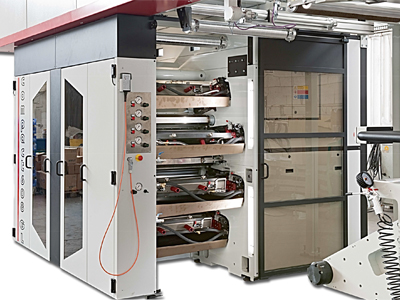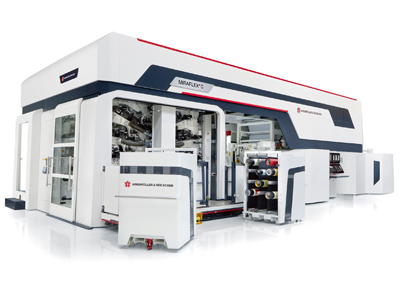The Miraflex C
The wider end of the flexo press spectrum has been upping its game recently. New presses have focused on making the entire printing process as streamlined and accurate as possible. Michal Lodej looks at how manufacturers have kept up with modern day market demands.
Comexi’s latest press has focused on reducing machine downtimes, printing quality and improvement of working conditions. These aims led to the development of the F1 and its automatic device for sleeve changeover. The press incorporates a robot capable of automatically manipulating all the sleeves that intervene in the printing process; printing sleeves, intermediate and anilox sleeves.
All sleeves are changed in automatic mode, saving time and effort, plus adding consistency and stability, which in the end raises overall performance of the whole plant.
The F1 also incorporates the latest solutions and innovations of Comexi´s consolidated product line, with enhanced ergonomics to improve changeovers such as the pipeless doctor blade system, better accessibility for maintenance tasks, and a high performance electronic system.
The company’s latest product targeting accuracy, precision and printing quality is the CingularReal2, which is the name given to the automatic system to make the pressure and register adjustment. The name stands for a real adjusting system, because when it finishes the adjust, it predicts the real printed result, meaning no further corrections need to be made. The system also finds the exact point for optimal printing quality with minimum overpressure, thus leading to better printing quality.
New and Improved
Soma has taken the Olympic games motto with a twist to describe the new Optima² press; faster, wider, better. The obvious change from the original optima press is width, which is now up to 1270 mm wide.
The new press also holds broad range of advancements, which developed from both the needs of printers, and ideas of the design team headed by Jan Verner.
The first step to a faster set up is to move the time consuming tasks like register and impression setting off the press. Together with the German manufacturer of high quality flexo printing presses Allstein GmbH, the company integrated the ARUN plate mounting system which not only mounts the next job, but also calculates the registration and impression setting offline on the plate mounter, while the press is still printing another job.
The ARUN – zero metre set-up waste system requires a slightly modified sleeve. These sleeves are supplied by several sleeve manufacturers including PolyWest, Flint Rotec and/or Rossini. During the process of plate mounting on the mounter, the crucial data for register and impression setting are stored in chips in the sleeve. According to the company, extensive testing consistently proves that even 1% highlight dots remain unharmed by the very smooth topography scan of the combined sleeve tape and plate combination. This information is then later read by the Optima² for fully automated register and impression setting.
In tests the total waste for impression and register setting had been reduced to five metres or fewer, which represents the circumference of the central impression drum and the approximate distance to achieve press speed.
Plate bounce may have plenty of causes such as the working condition of the press, printing form design, or repeat length. Soma’s approach to eradicate this is to use a single block printing unit frame to provide optimal rigidity and damping capabilities. All of the frames used for the press are solid and in average 130 mm thick, in some areas of the frame thick up to 200 mm, which helps the Advanced Bounce Control system
Based on the ARUN development project, the company has also started to cooperate with Allstein designers on how to increase machine position accuracy, and stability.
Other clever changes have made improvements to the press. One is the cooling of the cylinder housings at motor side, similar to the cooling of the central impression drum. This prevents any temperature caused expansion, and hence dot gain. Another clever feature had been developed for the interdeck dryers, which now swing open by 90 degrees. This eases cleaning, and provide easy accessibility to the substrate and CI drum. The new Bosch Rexroth drives with IPM (Integrated Permanent Magnet) save up to 8% energy. It has also integrated a servo unit for in-register reprint of bar codes or any other ink/varnish layers across full web width.
New designs
The Miraflex˝ C from Windmöller & Hölscher is an intelligent flexographic press created through optimised machine design and integrated automation modules, to further increase efficiency and sustainability.
The rear frame and the tunnel, the area between the printing unit and the rewind unit, have been redesigned. In the rear frame, all W&H inspection systems can be integrated as required. On the bridge, all auxiliary components are accommodated efficiently and with minimum use of space. Even when fitted with the maximum equipment, such as inline printing units, all components of the machine are optimally accessible. ‘We have paid special attention to intuitive operability and improved accessibility – the new design underlines these ergonomic improvements. We always work according to the principle that form follows function, not the other way around,’ explained Markus Bauschulte, head of customer technical support printing.
Another example for the innovations included in the new machine is the automatic cleaning of the impression cylinder. Up until now, soiling of the central cylinder meant considerable effort and expense as well as long machine down times for manual cleaning, but now press completes the process automatically in a minimum of time.
A new drying system also contributes to the increased efficiency and sustainability of the Miraflex˝ C. Modern frequency-controlled blowers and air ducts ensure top print performance with minimum use of energy.

Expert’s Compact press
Following the successful debut of Expert’s Comapct press at drupa, the flexo press builder is continuing to receive enquiries from visitors to the stand. The Compact lived up to its name, being the smallest of all the CI presses on display. With a print repeat of 650 mm and available in widths of 600 mm to 1m, the machine is of particular interest to printers who are looking for a small footprint flexo press.
KBA FlexoTechnica launched the new Neo XD LRcentral cylinder press, which according to the company was the only flexo press at drupa to print with water-based inks onto plastic film.
The press is a flexo hybrid, which can use different flexo inks such as solvent, water-based, UV-LED or EB inks, either as single printing process, or as a multi-process combination. These can run on the main central drum printing group as well as on inline units. This allows a wide range of different applications to be printed on the press.
The press can run with up to 12 colours with a cut-off from 400 to 1200 mm, a maximum web width of 1650 mm and a maximum printing speed of up to 500 m/min.
Uteco showed its new Onyx XS Eco One, a 8 colour, CI drum compact flexographic press for short runs, suitable also for label printing.
Onyx XS is the compact version of the Onyx range designed to optimise short runs and guarantee a higher quality printing subject standard. In addition to conventional air drying Onyx XS can be equipped with UV lamps or an EB curing unit. This new machine runs with a web width of 600 – 1000 mm and can run at up to 300 m/min. It is a flexo press developed to run with EB inks. With this technology, printing, coating/laminating and curing are all done inline in one pass. The press is able to print wet on wet, add a laminate or coating and then all be cured after. This speeds up production times considerably.
The press has a flexible configuration from basic single reel shaftless unwinder/rewinder to fully automatic ones, does not require ladders or stairs to access to upper decks, and new triple energy saving ventilation system for drying.






